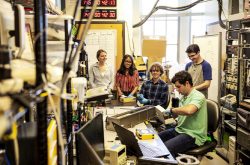
A University of Washington satellite smaller than a loaf of bread will, if all goes well, launch this weekend on its way to low-Earth orbit. It will be the first student-built satellite from Washington state to go into space.
HuskySat-1 is one of seven student-built satellites from around the country scheduled to launch at 9:30 a.m. Eastern time Saturday, Nov. 2, from NASA’s Wallops Flight Facility on the Virginia coast.
“It will be exciting once it’s in orbit,” said Paige Northway, a UW doctoral student in Earth and Space Sciences who has been involved since the project’s inception. “To me, the completion will be when we can get data from the satellite and send instructions back.”
HuskySat-1’s last moments on Earth will be broadcast live on NASA TV. The satellites are hitching a ride on the Cygnus cargo spacecraft, whose first stop will be the International Space Station to resupply astronauts and swap out materials. In early 2020 the spacecraft will leave the station and fly up to an altitude of about 310 miles (500 kilometers), where a NASA engineer will eject the student-build satellites.
The UW creation is a type of CubeSat, a small satellite that measures exactly 10 centimeters (about 3 inches) along each side. HuskySat-1 is a “three-unit” system, meaning it’s the shape of a stack of three CubeSat-sized blocks. These miniature satellites were first created as a way for engineering students to test software with smaller, cheaper devices they could build from start to finish in a few years. But the devices are growing in popularity, with Planet and other companies now using nanosatellites for commercial ventures.
Read more at UW News »
